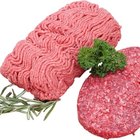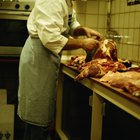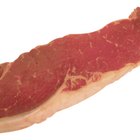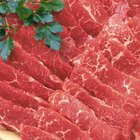
Jupiterimages/Photos.com/Getty Images
When you're standing at the butcher's counter, it's easy to get lost in a sea of jargon, and no one can blame you for confusing a tri-tip steak for a flat half brisket. To begin your journey into the finer details of beef cuts, it is essential to know the eight basic parts of the cow. From there, you'll discover where terms such as “sirloin,” “tip” and “roast” come into play in the kitchen.
Basics
Butchers divide the cow into eight basic cuts of consumable meat. The portion from the lower neck to upper shoulder is the chuck, while the chest area is where the brisket lies. Rib cuts come from the front portion of the torso while loin cuts come from the rear. The rump and hind leg of the cow compose the round and the area just below the loin is called the flank. The front legs lend themselves to shank cuts, and just behind the front legs, lies the plate.
Sirloin
Top and bottom sirloin cuts are both parts of the loin. Juicy top sirloin cuts come from the upper-rear portion of the loin while bottom sirloin cuts come from the area just above the flank. The center sirloin cut and the affordable, versatile sirloin steak are some of the most famous sirloin cuts, and the sirloin steak lends itself to grilled or pan-fried steaks, including savory recipes such as herb-marinated steak or steak with mushroom cream sauce. Unlike sirloin steak cuts, top sirloin cuts are boneless, making them well suited for roasts. In particular, top sirloin excels in dishes such as vegetable beef stir-fry, Hawaiian grilled kabobs and even beef-and-fennel salad. Sirloin cuts feature a marbled texture and pack plenty of beefy flavor. Marinate your sirloin before cooking it, to add additional tenderness.
"Tip" Cuts
While there is no specific cut of beef known as the “tip,” many cuts feature the word. Common “tip” cuts come from the round of the cow, including sirloin tip roasts and the tender sirloin-tip center steaks. Tri-tip cuts, including lean, richly flavored tri-tip steaks and tri-tip roasts, come from the sirloin of the cow. The flat shape of the tri-tip steak caters to grilling and broiling -- with recommended recipes that include fajitas, quesadillas and beef Caesar salad -- while the tri-tip roast caters to roasting, because it is boneless and you can cook it whole. In particular, tri-tip roasts accommodate stuffed roasts.
Cuts for Roasting
Roast cuts are not a particular type of meat; rather, they are cuts with a thick, rounded shape that caters to roasting, a slow cooking method that uses dry or moist heat to create a crisp exterior and a juicy, tender interior. You can use cuts from nearly every portion of the cow as roasts, including top sirloin, tenderloin, tri-tip, round tip, rib eye and chuck roast cuts. Each of these cuts features additional, separate cuts, but some roast cuts include the top blade and seven-bone roast cuts of the chuck -- both of which offer deep beef flavor at a value price. The top blade features connective tissue and the seven-bone needs to be cut thinly. Chuck roasts are versatile, and lend themselves to pot roasts, as well as slow-cooker roasts, chilies and stews. Other roasts have qualities that pair well with specific recipes; for instance, the moderately moist top sirloin roast goes well with fruit glazes while the finely textured tenderloin roast pairs nicely with savory flavors such as garlic and rosemary.
Related Articles

What Cuts of Meat Are Used for Ground ...

Brisket vs. Tri-Tips

Cuts of Meat From a Front Quarter of ...

Does a Rib Eye Have a Filet in It?

What Is a Chateau Cut?
What Part of the Cow Is Boneless Beef ...

Meat Parts of a Lamb

How to Make an Eye of Round Less Tough ...

What Is the Difference in Top Sirloin & ...

How to Marinate a Top Round Roast

How to Convection Roast a Brisket

Different Cuts of Steak

How to Cook a 15-Pound Rib Roast

How to Cook Kobe Steaks
How to Make Beef Bottom Round Roast ...

What Is a Tip Roast?

How to Cook London Broil

Can Chuck Roast Be Used for Stew?

The Difference Between a Sirloin Roast ...

Do You Need to Marinate Flat Iron Steak ...
References
- Stubb's BBQ: Cow Cuts 101
- Cattlemen's Beef Board and National Cattlemen's Beef Association: Meet the Top Five Most Popular Beef Cuts
- Certified Angus Beef: Roasting
- Today: A Meaty Guide to the Best Cuts and Types of Beef
- American Angus Association: Angus Beef Chart
- Certified Angus Beef LLC: Beef Cuts
Resources
Writer Bio
With a diverse professional background and a decade of experience as a freelance writer, Dan has contributed lifestyle content -- from fashion to travel to fitness and more -- to publishers including Chron, Fortune, Sony, GlobalPost, ModernMom, Moviefone, Salon.com, Techwalla and dozens of others.
Photo Credits
Jupiterimages/Photos.com/Getty Images